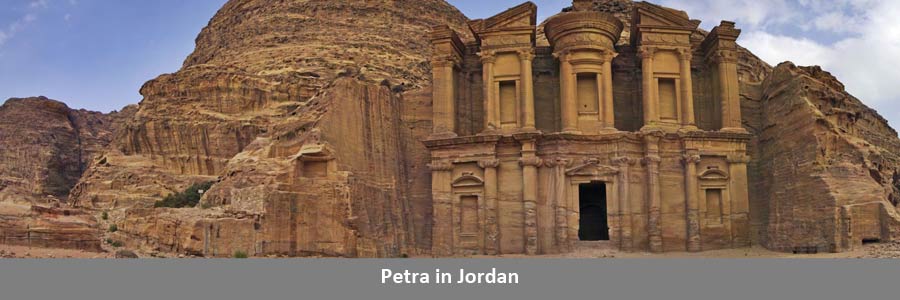Petra in Jordan
Petra in Jordan
On the slopes of Mount Hor in the Arabah section of Jordan you’ll find Petra. The site is considered one of the most stunning architectural attractions in the world, with each building cut directly into the mountain wall. Both the interior and exterior artwork is astounding.
The site wasn’t discovered until 1812, but it is believed that the area had been occupied since as early as the Eighteenth Dynasty of Egypt. The government has now designed an official “Visitor Centre” to accommodate tourists. The site is has been listed as World Heritage Site since 1985.
The best time to travel Jordan is in spring (March to May) and autumn (September to November). Summer (May to September) is hot and dry, and winter (December to February) can be cold with the occasional snowfall.
_______________
Tours
Madaba Tour
Transfer to Petra via the Kings Highway, which twists and winds its way through the heart of Jordan. Visit the mosaic city of Madaba en-route, where the oldest map of the Holy Land exists on the floor of the Church of St. George. Stop at Mt. Nebo, where the Bible says Moses lived out his remaining days and viewed the Promised Land. Continue south through the breathtaking scenery of Wadi Mujib and visit the Crusader Castle at Kerak. Arrive in Wadi Mousa, the modern village of Petra.
The Lost Nabatean city of Petra
Visit the lost Nabatean city of Petra. Discover El Khazneh, one of the most elegant remains of antiquity. It is carved out of solid rock from the side of a mountain and stands over 40m high. Spend the day exploring Petra, one of the Wonders of the World.
Wadi Rum
Discover the magical desert of Wadi Rum, the home of “Lawrence of Arabia”. Tour this moon-like landscaped desert in a jeep. Return to Amman via the Desert Highway.
Cairo Tour
The perfect orientation tour of Cairo; Morning tour of the Egyptian Museum, view the largest depository of Egyptian Antiquities from the Pharaonic and Greco Roman periods as well as the treasures recovered from the Tomb of Tut- Ankh-Amun. Afternoon visit to the Great Pyramids of Giza, the only present day survivor of the Seven Wonders of the Ancient World, built from over 2300 000 blocks of stone, each weighing about 2.5 tons. Nearby, the mystical Sphinx keeps watch over the Giza plateau. The 20m high man-animal Sphinx, created as a “living image of the sun-god”, was built by Chephren to guard the entrance to the Pyramids.
Tags: Travel Incentives

